Design of the Radio Frequency Section of a Ka-Band Multiple Beam Ladder-Type Extended Interaction Klystron
Abstract
:1. Introduction
2. Design Approach
3. Simulation Results
3.1. Design of the Intermediate Cavity
3.2. Design of the Input/Output Cavities
3.3. Design of the RF Section
4. Conclusions
Author Contributions
Funding
Acknowledgments
Conflicts of Interest
References
- Liao, S.Y. Microwave Devices and Circuits, 3rd ed.; Pearson Education: Noida, India, 2003; ISBN 9788177583533/8177583530. [Google Scholar]
- Gilmour, A.S., Jr. Microwave Tubes; ArtechHouse: Nordwood, MA, USA, 1986. [Google Scholar]
- Smith, M.J.; Phillips, G. Power Klystrons Today. Research Studies Press Ltd.: Baldock, UK, 1995. [Google Scholar]
- Korolyov, A.N.; Gelvich, E.A.; Zhary, Y.V.; Zakurdayev, A.D.; Poognin, V.I. Multiple-beam Klystron Amplifiers: Performance Parameters and Development Trends. IEEE Trans. Plasma Sci. 2004, 32, 1109–1117. [Google Scholar] [CrossRef]
- Nguyen, K.T.; Abe, D.K.; Pershing, D.E.; Levush, B.; Wright, E.L.; Bohlen, H.; Staprans, A.; Zitelli, L.; Smithe, D.; Pasour, J.A.; et al. High-power Four Cavity S-band Multiple-beam Klystron Design. IEEE Trans. Plasma Sci. 2004, 32, 1119–1135. [Google Scholar] [CrossRef]
- Maity, S.; Bandyopadhyay, A.K.; Joshi, L.M. Design of Radio Frequency Cavities for a J-Band Multibeam Klystron. IETE J. Res. 2012, 58, 310–316. [Google Scholar] [CrossRef]
- Larionov, A.; Teryaev, V.; Matsumoto, S.; Chin, Y.H. Design of multi-beam klystron in X-band. Proceeding of the 27th Linear Accelerator Meeting in Japan, Kyoto, Japan, 7–9 August 2002. [Google Scholar]
- Bandyopadhyay, A.K.; Maity, S.; Joshi, L.M.; Kant, D.; Singh, A.K. Design of the Radio Frequency Section of a Multiple Beam Klystron working in the J-band Frequency Range. In Proceedings of the IEEE 14th International Vacuum Electronics Conference (IVEC), Paris, France, 21–23 May 2013. [Google Scholar] [CrossRef]
- Bandyopadhyay, A.K.; Joshi, L.M.; Pal, D.; Kant, D.; Meena, R.; Kumar, B.; Maity, S.; Rawat, V.S.; Saha, S. Development of the Radiofrequency Section of a Ku-band Multiple-Beam Klystron. IETE J. Res. 2016, 62, 859–865. [Google Scholar] [CrossRef]
- Shin, Y.M.; Park, G.S.; Scheitrum, G.P.; Caryotakis, G. Circuit Analysis of an Extended Interaction Klystron. J. Korean Phys. Soc. 2004, 44, 1239–1245. [Google Scholar]
- Li, R.; Ruan, C.; Zhang, H.; He, Y.; Shan, S. Improvement of Output Power in G-band EIK with Optimized and Tapering Gap Length. In Proceedings of the IEEE International Vacuum Electronics Conference (IVEC), Monterey, CA, USA, 24–26 April 2018; pp. 24–26. [Google Scholar] [CrossRef]
- Chang, Z.; Meng, L.; Yin, Y.; Wang, B.; Li, H.; Rauf, A.; Ullah, S.; Bi, L.; Peng, R. Circuit Design of a Compact 5-kV W-Band Extended Interaction Klystron. IEEE Trans. Electron Devices 2018, 65, 1179–1184. [Google Scholar] [CrossRef]
- Roitman, A.; Berry, D.; Steer, B. State-of-the-art W-band extended interaction klystron for the CloudSat program. IEEE Trans. Electron Devices 2005, 52, 895–898. [Google Scholar] [CrossRef]
- Nguyen, K.T.; Pershing, D.; Wright, E.L.; Pasour, J.; Calame, J.; Ludeking, L.; Rodgers, J.; Petillo, J. Sheet-beam 90 GHz and 220 GHz extendinteraction-klystron designs. In Proceedings of the IEEE IVEC, Kitakyushu, Japan, 15–17 May 2007; pp. 1–2. [Google Scholar] [CrossRef]
- Durand, A.J.; Durand, A.J. PPM focused Ku band pulsed EIK. In Proceedings of the IEEE International Vacuum Electronics Conference held Jointly with 2006 IEEE International Vacuum Electron Sources, Monterey, CA, USA, 25–27 April 2006; pp. 73–74. [Google Scholar] [CrossRef]
- Berry, D.; Deng, H.; Dobbs, R.; Horoyski, P.; Hyttinen, M.; Kingsmill, A.; Machattie, R.; Sokol, E.; Steer, B. Practical aspects of EIK technology. IEEE Trans. Electron Devices 2014, 61, 1830–1835. [Google Scholar] [CrossRef]
- Wright, E.L.; Shabazian, A.; Cecil, M. Ka-band klystron amplifiers for satellite communications and scientific applications. Abstracts. In Proceedings of the International Vacuum Electronics Conference 2000 (Cat. No.00EX392), Monterey, CA, USA, 2–4 May 2000; p. 2. [Google Scholar] [CrossRef]
- Behtouei, M.; Faillace, L.; Ferrario, M.; Spataro, B.; Variola, A. Initial Design of a High-Power Ka-Band Klystron. J. Phys. Conf. Ser. 2020, 1596, 012023. [Google Scholar] [CrossRef]
- Cai, J.C.; Syratchev, I.; Burt, G. Design Study of a High-Power Ka-Band High-Order-Mode Multibeam Klystron. IEEE Trans. Electron Devices 2020, 67, 5736–5742. [Google Scholar] [CrossRef]
- Chodorow, M.; Kulke, B. An extended-interaction klystron: Efficiency and bandwidth. IEEE Trans. Electron Devices 1966, ED-13, 439–447. [Google Scholar] [CrossRef]
- Barker, R.J.; Booske, J.H.; Luhmann, N.C.; Nusinovich, G.S. Klystrons in Modern Microwave and Millimeter-Wave Power Electronics, 1st ed.; IEEE Press: Piscataway, NJ, USA, 2005; pp. 131–147. [Google Scholar]
- Campbell, C.F.; Nayak, S.; Kao, M.; Chen, S. Design and performance of 16–40GHz GaN distributed power amplifier MMICs utilizing an advanced 0.15µm GaN process. In Proceedings of the 2016 IEEE MTT-S International Microwave Symposium (IMS), San Francisco, CA, USA, 22–27 May 2016; pp. 1–4. [Google Scholar] [CrossRef]
- Neininger, P.; John, L.; Zink, M.; Meder, D.; Kuri, M.; Tessmann, A.; Friesicke, C.; Mikulla, M.; Quay, R.; Zwick, T. Broadband 100-W Ka-Band SSPA Based on GaN Power Amplifiers. IEEE Microw. Wirel. Compon. Lett. 2022, 32, 708–711. [Google Scholar] [CrossRef]
- Bi, L.; Meng, L.; Yin, Y.; Xu, C.; Zhu, S.; Peng, R.; Zeng, F.; Chang, Z.; Wang, B.; Li, H.; et al. Design and Analysis of a High-Order Mode Ladder-Type RF Circuit for Stable Operation in a W-Band Extended Interaction Oscillator. IEEE Trans. Electron Devices 2019, 66, 729–735. [Google Scholar] [CrossRef]
- Li, S.; Ruan, C.; Fahad, A.K.; Wang, P.; Zhang, Z.; He, W. Novel Coupling Cavities for Improving the Performance of G-Band Ladder-Type Multigap Extended Interaction Klystrons. IEEE Trans. Plasma Sci. 2020, 48, 1350–1356. [Google Scholar] [CrossRef]
- Zhao, D.; Liu, G.; Gu, W.; Ma, T.; Xue, Q.; Zhang, Z. Development of a High Power Ka-Band Extended Interaction Klystron. In Proceedings of the IEEE International Vacuum Electronics Conference (IVEC), Busan, Korea, 28 April–1 May 2019. [Google Scholar]
- Li, R.; Ruan, C.; Zhang, H. Design and optimization of G-band extended interaction klystron with high output power. Phys. Plasmas 2018, 25, 033107. [Google Scholar] [CrossRef]
- Lv, S.; Zhang, C.; Wang, S.; Wang, Y. Stability analysis of a planar multiple-beam circuit forW-band high-power extended-interaction klystron. IEEE Trans. Electron Devices 2015, 62, 3042–3048. [Google Scholar] [CrossRef]
- Yin, Y.; Zeng, F.; Wang, B.; Li, H.; Bi, L.; Chang, Z.; Peng, R.; Zhu, S.; Xu, C.; Meng, L.; et al. Preliminary Study of a Multiple-Beam Extended-Interaction Oscillator with Coaxial Structure. IEEE Trans. Electron Devices 2018, 65, 2108–2113. [Google Scholar] [CrossRef]
- Qin, Y.; Yin, Y.; Xu, C.; Yang, T.; Chen, Q.; Xu, X.; Xie, J.; Bi, L.; Wang, B.; Li, H.; et al. Analysis of the Resonator Part of a Ka-Band Multiple-Beam Extended-Interaction Oscillator through Electric Field Uniformity. Electronics 2021, 10, 276. [Google Scholar] [CrossRef]
- Lin, F.-M.; Wu, S.; Xiao, Y.; Zhang, L. A 0.3 THz Multi-Beam Extended Interaction Klystron Based on TM10,1,0 Mode Coaxial Coupled Cavity. IEEE Access 2020, 8, 214383–214391. [Google Scholar] [CrossRef]
- Maity, S.; Kumar, M.; Koley, C.; Pal, D.; Bandyopadhyay, A. Design and Simulation of Extended Interaction Cavities for a Ka band Multi beam Klystron. DSJ 2021, 71, 320–323. [Google Scholar] [CrossRef]
- Zhang, X.; Zhang, R.; Wang, Y.; Chao, Q.; Xie, B.; Chen, H.; Guo, N. Design study of a W-band high power extended interaction klystron based on the coaxial high-order mode. AIP Adv. 2021, 11, 125210. [Google Scholar] [CrossRef]
- Wang, D.; Wang, G.; Wang, J.; Li, S.; Zeng, P.; Teng, Y. A high-order mode extended interaction klystron at 0.34 THz. Phys. Plasmas 2017, 24, 023106-1–023106-8. [Google Scholar] [CrossRef]
- Wright, E.; Balkcum, A.; Bohlen, H.; Cattelino, M.; Cox, L.; Cusick, M.; Falce, L.; Friedlander, F.; Stockwell, B.; Zitelli, L. Development of a 10-MW, L-band, multiple-beam klystron for TESLA. In Proceedings of the IEEE Particle Accelerator Conference, Portland, OR, USA, 12–16 May 2003. [Google Scholar] [CrossRef]
- Zhang, X.; Zhang, R.; Wang, Y. Research on a High-Order Mode Multibeam Extended-Interaction Oscillator with Coaxial Structure. IEEE Trans. Plasma Sci. 2020, 48, 1902–1909. [Google Scholar] [CrossRef]
- Chodorow, M.; Wessel-Berg, T. A high-efficiency klystron with distributed interaction. IRE Trans. Electron Devices 1961, 8, 44–55. [Google Scholar] [CrossRef]
- Symons, R.S.; Vaughan, R.M. The linear theory of the clusteredcavity klystron. IEEE Trans. Plasma Sci. 1994, 22, 713–718. [Google Scholar] [CrossRef]
- User’s Manual, CST Studio Suite—2019; Dassault Systems: Vélizy-Villacoublay, France, 2019.
- Ansoft HFSS (Version 10), Users Manual, Ansoft Corporation. Available online: http://www.ansys.com (accessed on 22 September 2012).


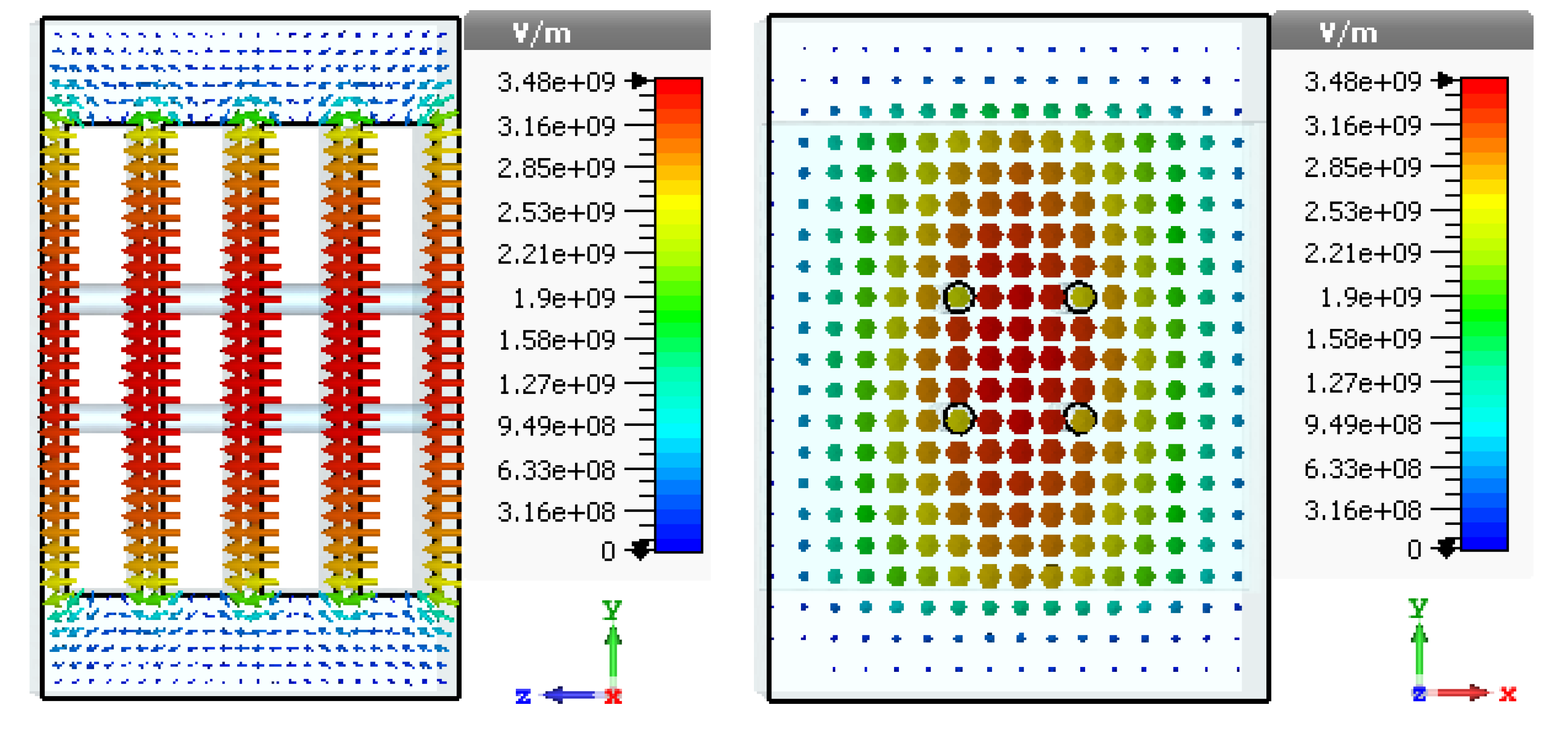

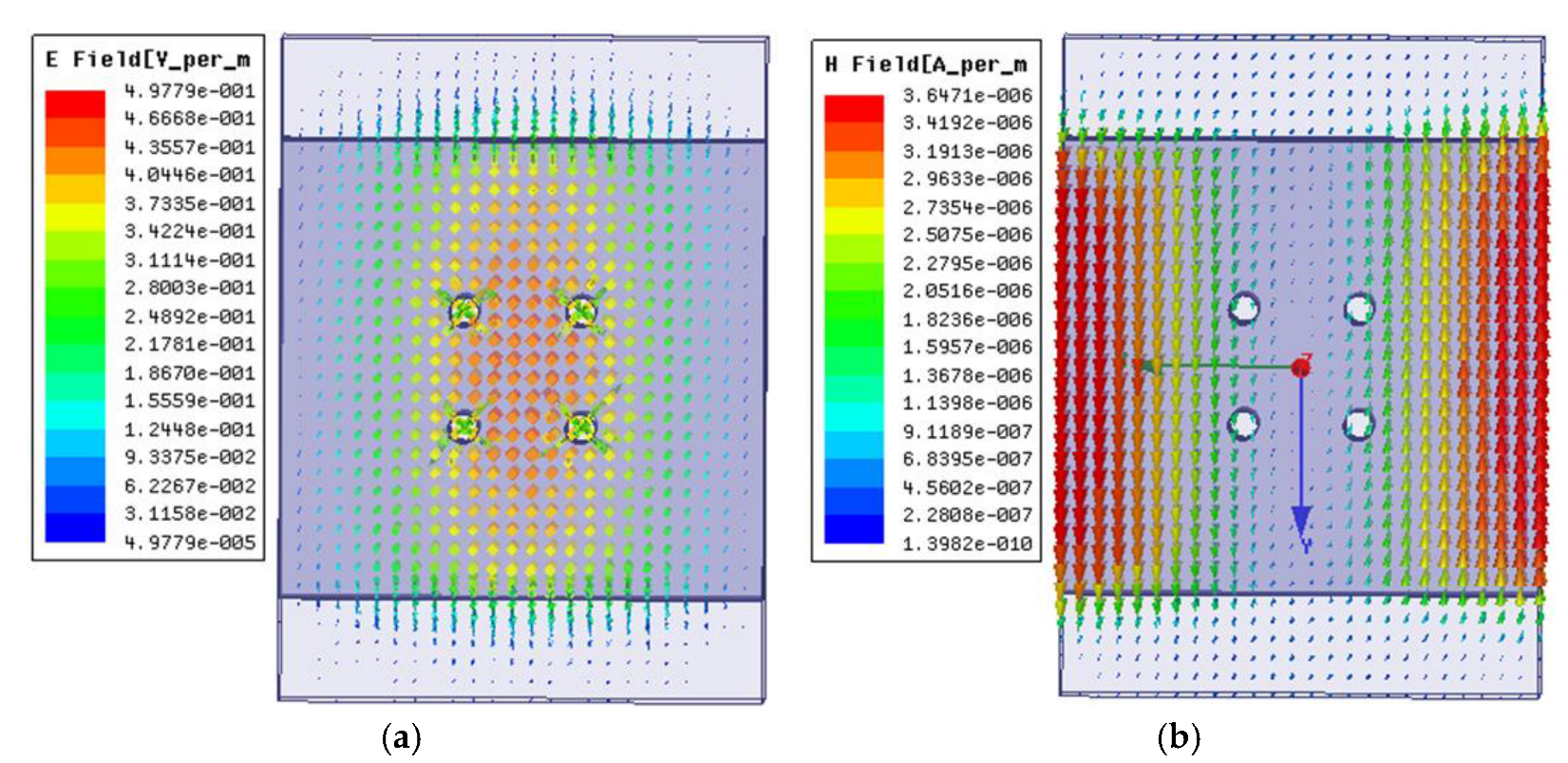



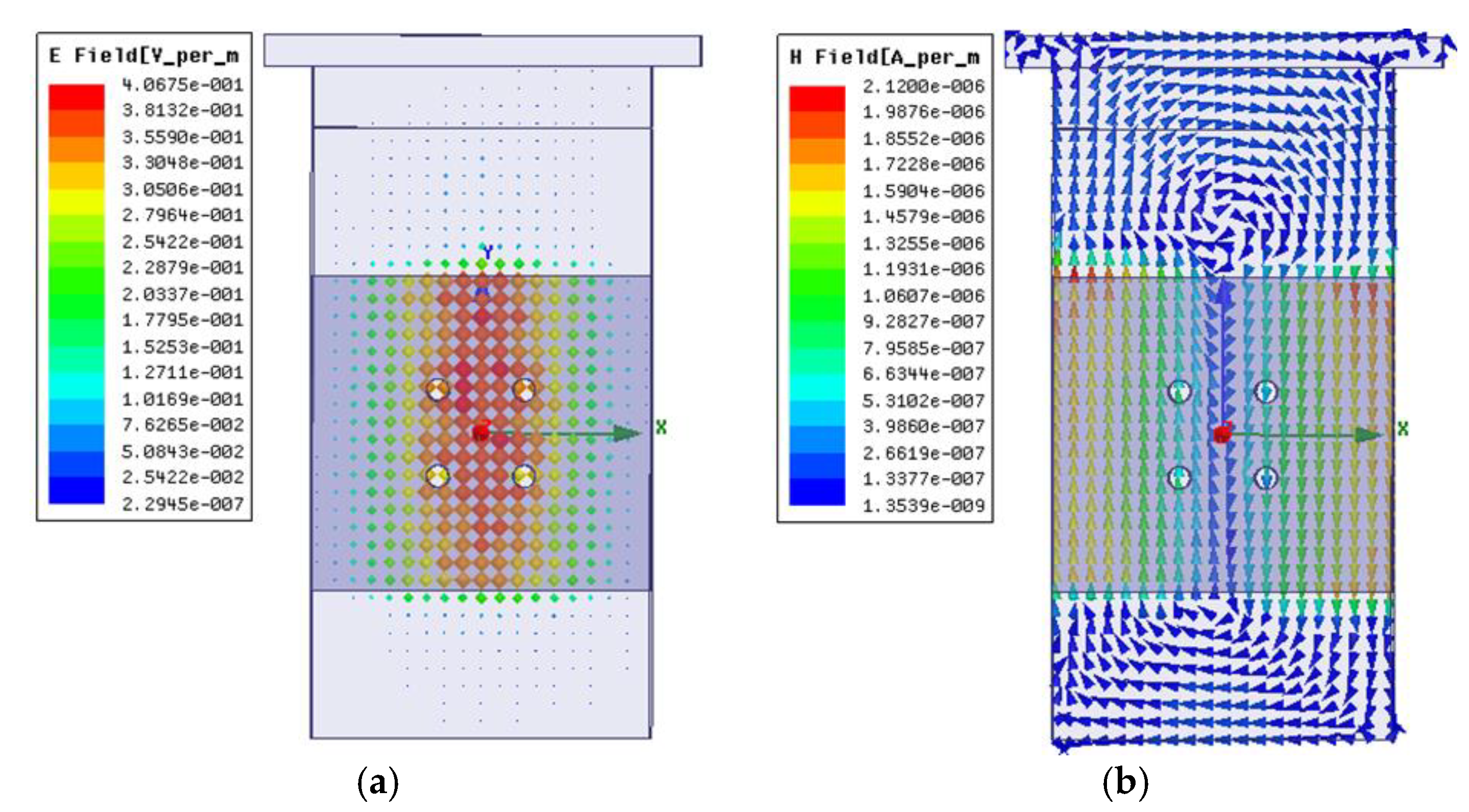



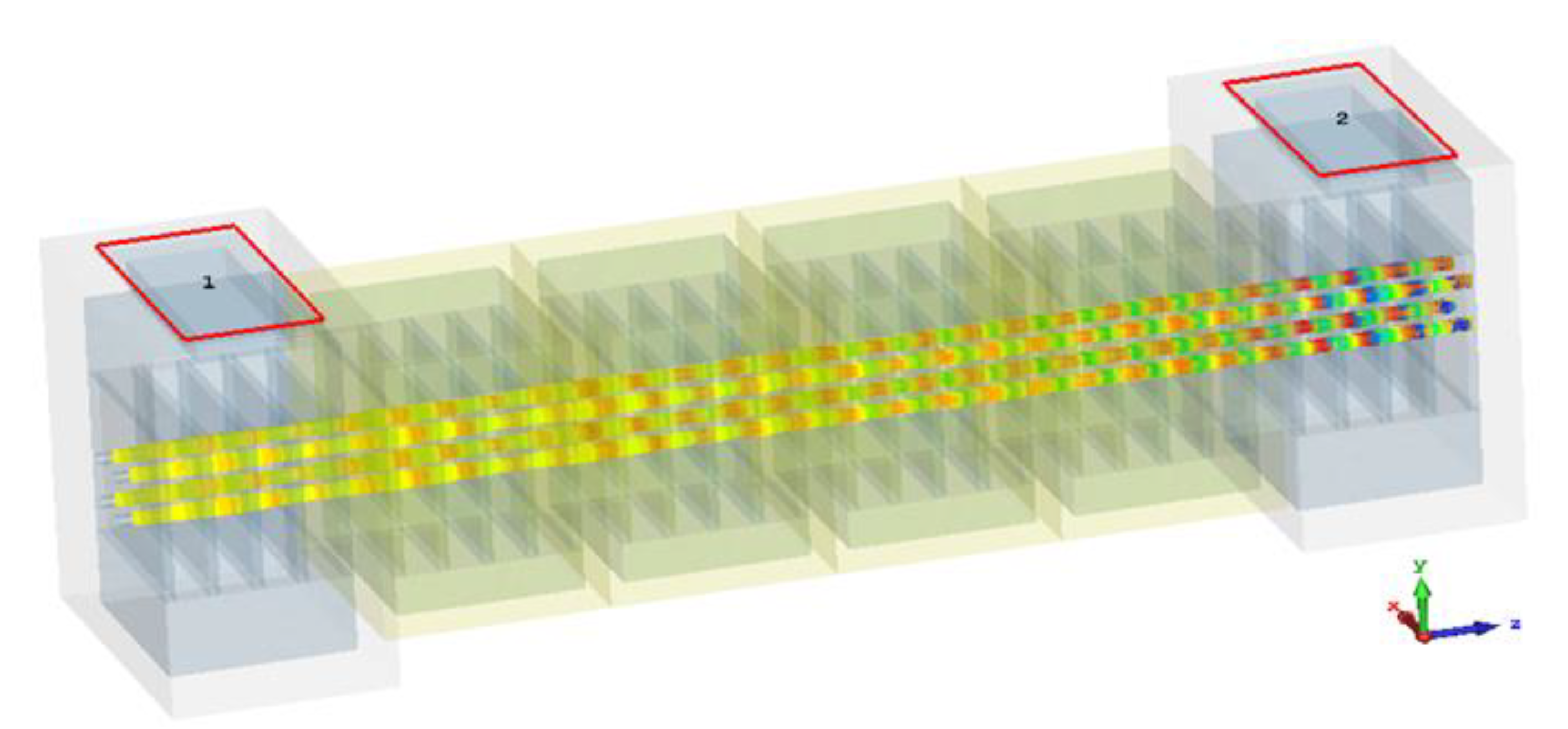
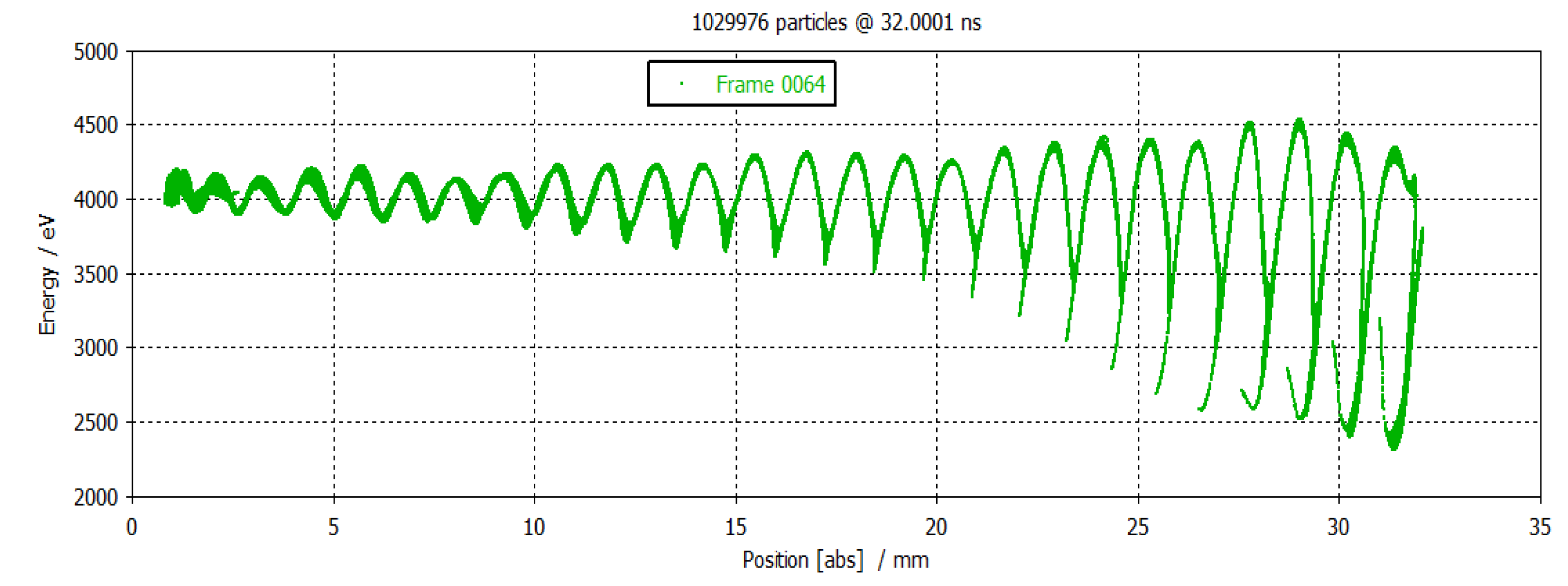



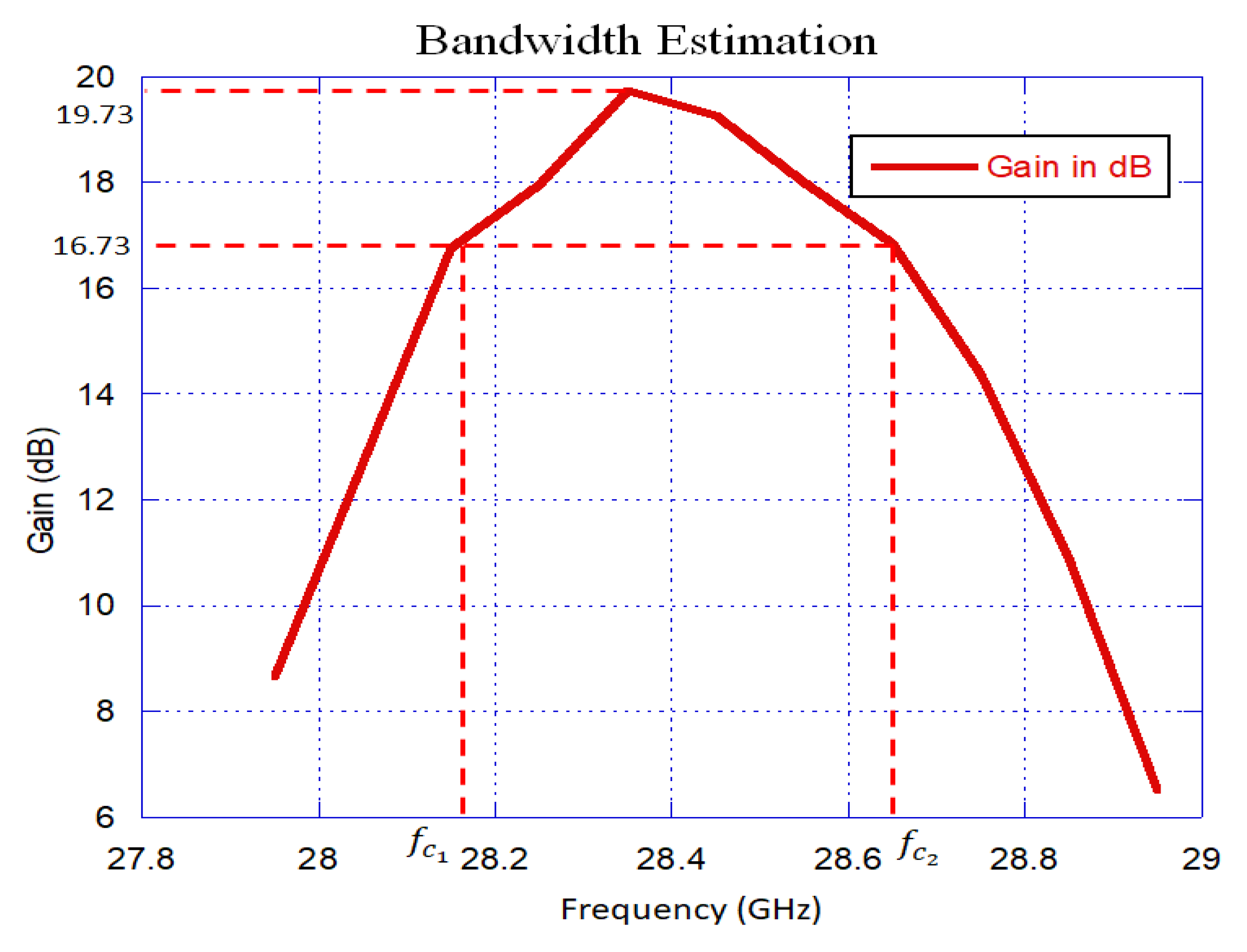

| Parameter | Specifications |
|---|---|
| Operating Frequency | 28.5 GHz |
| Bandwidth | 500 MHz (min) |
| Beam Voltage | 4 kV |
| Beam Current | 0.196 A |
| No. of beams | 4 |
| Parameter | Value (mm) |
|---|---|
| X | 5.8 |
| Y | 7.96 |
| Z | 4.83 |
| H | 5.5 |
| D | 0.36 |
| GAP | 0.27 |
| P | 1.14 |
| Parameters | Values from CST | Values from HFSS |
|---|---|---|
| Resonant Frequency (GHz) | 28.53 | 28.52 |
| Q | 720 | 708 |
| R (MΩ) | 35.07 | 35.09 |
| R/Q | 48.7 | 49.56 |
| Parameters | Value (mm) |
|---|---|
| X | 5.5 |
| Y | 9.9 |
| Z | 4.83 |
| H | 5.1 |
| D | 0.36 |
| GAP | 0.27 |
| P | 1.14 |
| A | 5.5 |
| B | 2.5 |
| h | 1 |
| Parameters | Values from CST | Values from HFSS |
|---|---|---|
| Resonant Frequency (GHz) | 28.53 | 28.52 |
| Q | 720 | 702 |
| R (MΩ) | 31.85 | 34.04 |
| R/Q | 44.2 | 48.5 |
| SIGNAL | Port-1 | Port-2 |
|---|---|---|
| Amplitude (sqrt(W)) | 2.0 | 19.39 |
| Peak Power (W) | 4.00 | 375.97 |
| RMS Power (W) | 2.0 | 187.98 |
| Beam Voltage (kV) | 4.00 | |
| Beam Current (A) | 0.196 | |
| Gain in Db | 19.73 | |
| Bandwidth (−3 dB) | 510 MHz | |
| Bandwidth (−1 dB) | 180 MHz | |
| Efficiency in % | 23.98% | |
Publisher’s Note: MDPI stays neutral with regard to jurisdictional claims in published maps and institutional affiliations. |
© 2022 by the authors. Licensee MDPI, Basel, Switzerland. This article is an open access article distributed under the terms and conditions of the Creative Commons Attribution (CC BY) license (https://creativecommons.org/licenses/by/4.0/).
Share and Cite
Maity, S.; Kumar, M.S.; Koley, C.; Pal, D.; Bandyopadhyay, A.K. Design of the Radio Frequency Section of a Ka-Band Multiple Beam Ladder-Type Extended Interaction Klystron. Electronics 2022, 11, 3781. https://doi.org/10.3390/electronics11223781
Maity S, Kumar MS, Koley C, Pal D, Bandyopadhyay AK. Design of the Radio Frequency Section of a Ka-Band Multiple Beam Ladder-Type Extended Interaction Klystron. Electronics. 2022; 11(22):3781. https://doi.org/10.3390/electronics11223781
Chicago/Turabian StyleMaity, Santigopal, Madutha Santosh Kumar, Chaitali Koley, Debashish Pal, and Ayan Kumar Bandyopadhyay. 2022. "Design of the Radio Frequency Section of a Ka-Band Multiple Beam Ladder-Type Extended Interaction Klystron" Electronics 11, no. 22: 3781. https://doi.org/10.3390/electronics11223781
APA StyleMaity, S., Kumar, M. S., Koley, C., Pal, D., & Bandyopadhyay, A. K. (2022). Design of the Radio Frequency Section of a Ka-Band Multiple Beam Ladder-Type Extended Interaction Klystron. Electronics, 11(22), 3781. https://doi.org/10.3390/electronics11223781









